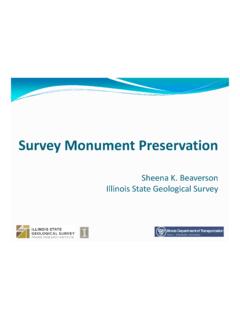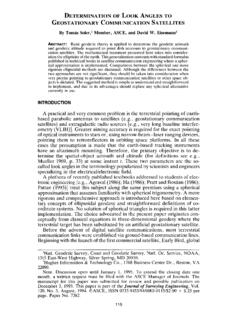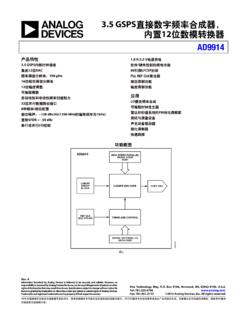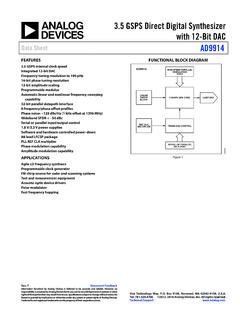Transcription of The DSDATA Format
1 The DSDATA Format Overview Information about survey monuments (aka marks ) stored in the National Geodetic Survey's Integrated Database (NGS IDB) may be retrieved and displayed in a variety of methods. One standard is known as a datasheet, an ASCII text file consisting of rigorously formatted lines of 80 columns. The name of the Format of a datasheet is called Digital Survey Data or DSDATA Format . Whether a user is extracting one datasheet, or many, the data is put into one file, and often referred to as a DSDATA . file.. When multiple datasheets are extracted for a user, the datasheets are presented in one DSDATA file in the order requested by the user. Users should be aware that not every survey monument in the NGS. IDB contains information that is publishable ( available to the public). The non-publishability reason for each such station will be given as part of the retrieval.
2 All examples of DSDATA found below will be presented in Courier Format , colored red. The most common method of retrieving datasheets in the DSDATA Format is through the NGS web page, where a Perl script runs queries via an NGS program called datasheet95 . As such, users often will see this as their first line, when retrieving DSDATA files: PROGRAM = datasheet95, VERSION = That line is metadata, telling the user how the DSDATA file itself was retrieved. The next line is the first line of actual DSDATA , and is the first line of the first datasheet to be retrieved. The first line of each datasheet is: 1 NATIONAL GEODETIC SURVEY, Retrieval Date = Month Day, Year Note that in the DSDATA Format , every line except line 1 of every datasheet has a blank space in the first column. Datasheets do not have an official last line Format . As such, when there are multiple datasheets in one DSDATA file, they can be separated by identifying their first lines, as per above.
3 The final line of a DSDATA file does have an official Format . The last line of a correctly retrieved DSDATA file is: **retrieval complete. If that retrieval was performed on the NGS web page, there is often one final non- DSDATA line of metadata, showing how long the retrieval took: Elapsed Time = 00:00:21. Page: 1 Updated: 12/15/2020. The second line of each datasheet begins with a blank space in column 1, followed by the six-character Permanent Identifier (PID) in columns 2-7, a blank space in column 8 and then a row of asterisks that begins in column 9, for example: AB1234 **. The remaining lines of each datasheet can be broken down into sections, where each section contains multiple 80 character lines. The sections are: Basic Metadata Current Survey Control Accuracy Data Determination Methodology Projections Azimuth Marks Superseded Survey Control Monumentation History Description and Recovery Each section will be described in detail below.
4 Basic Metadata The Basic Metadata Section contains information to help identify the kind of mark, its name, and where it can generally be found. Each line will contain one data item, though not every data item is displayed on every datasheet. The data items which may occur on datasheets, in the order they will appear, are listed in the tables below. Data Item Special Category Header When Displayed Only when mark belongs to one or more of the categories shown in the examples below. Comments Marks can belong Marks can belong to more than one of these categories. In such a case all of the appropriate categories will be displayed Examples: AF9520 CORS - This is a GPS Continuously Operating Reference Station. HV8128 FBN - This is a Federal Base Network Control Station. HV9260 CBN - This is a Cooperative Base Network Control Station. RF0849 PACS - This is a Primary Airport Control Station.
5 RF0850 SACS - This is a Secondary Airport Control Station. DM9926 HT_MOD - This is a Height Modernization Survey Station. AE8289 WATER LEVEL - This is a Water Level Survey Control Monument. TV1513 DATUM ORIG - This is a Vertical Datum Origin Point. CJ0500 TIDAL BM - This is a Tidal Bench Mark. Page: 2 Updated: 12/15/2020. Data Item Designation When Displayed Always Comments The designation is often called the name of the mark. Often the DESIGNATION. line does not match exactly with the STAMPING line (see later). Examples: HV1846 DESIGNATION - MERIDIAN STONE. RF0849 DESIGNATION - CARIPORT. CA0570 DESIGNATION - MP 77-5015. AA8531 DESIGNATION - 66-26. Data Item CORS Identifier When Displayed When the mark is either a Continuously Operational Reference Station (CORS) or is associated with one Comments Associated with means it is either the Antenna Reference Point (ARP) of a CORS, a CORS monument, or a Ground Reference Point (GRP).
6 CORS identifiers are always four character alphanumeric values. Examples: AF9520 CORS_ID - WES2. DP3834 CORS_ID - AC53. DJ3083 CORS_ID - GAIT. DP4062 CORS_ID - WES2. AF9647 CORS_ID - GODE. Data Item Permanent Identifier (aka PID ). When Displayed Always Comments The PID is also found on the left side (columns 2-7) of each datasheet record. The PID is always 2 upper case letters followed by 4 numbers. Examples: DP3834 PID - DP3834. RF0849 PID - RF0849. TV0007 PID - TV0007. AB1234 PID - AB1234. Data Item State/County When Displayed Always, but County may be blank. Comments State can mean an actual state, or the District of Columbia or one of a number of insular areas. The 2-character abbreviation for all other areas is specific to NGS and does not necessarily follow any other official style or rule. Some states may not have counties.
7 Boroughs may be used for Alaska; Parishes are used for Louisiana; Districts and/or Islands for American Samoa. Examples: FV1057 STATE/COUNTY- CA/SAN LUIS OBISPO. HV4442 STATE/COUNTY- DC/DISTRICT OF COLUMBIA. BW0029 STATE/COUNTY- LA/POINTE COUPEE. AA4438 STATE/COUNTY- FM/KOSRAE. TT4608 STATE/COUNTY- AK/MATANUSKA-SUSITNA. DE7254 STATE/COUNTY- AS/EASTERN (DISTRICT). ad9914 STATE/COUNTY- ON/HASTINGS. Page: 3 Updated: 12/15/2020. Data Item Country When Displayed Always Comments NGS has certain restrictions on publication of points outside of the USA. Examples: HV1846 COUNTRY - US. AB9729 COUNTRY - BARBADOS. AA4438 COUNTRY - FEDERATED STATES OF MICRONESIA. ad9914 COUNTRY - CANADA. Data Item USGS Quadrangle When Displayed Always, but may be blank Comments This is the name of the USGS minute series map sheet which shows the area of the mark.
8 The mark may or may not appear as a map feature. NGS sometimes publishes data according to the USGS quadrangle (quad) system, for which the USGS quad sheet name is used as a reference. Examples: FA3038 USGS QUAD - ELLENDALE (2019). RF0850 USGS QUAD - CARIBOU (2018). TV1290 USGS QUAD - CAMUY (2018). FV1057 USGS QUAD - CYPRESS MOUNTAIN (2018). Data Item National Topographic System Map Sheet for Canada When Displayed Always, but may be blank Comments When a USGS topographic quadrangle or a Canadian NTS Map Sheet map name is known, a station listing of all datasheets within each map's mapping area can be found by using these web pages: Examples: TN1099 NTS MAPSHEET- SAGE CREEK (2020). TT3837 NTS MAPSHEET- WHITE PASS (2020). TD0631 NTS MAPSHEET- ALTONA (2020). OG0249 NTS MAPSHEET- NIAGARA (2020). Page: 4 Updated: 12/15/2020. Current Survey Control The Current Survey Control Section contains the most recent geodetic coordinates available for the mark, even if those coordinates are not in the most recent datum or datum realization of the National Spatial Reference System (see Appendix A).
9 Each line will contain one data item, though not every data item is displayed on every datasheet. The top of this section will consist of three lines: AB1234. AB1234 *CURRENT SURVEY CONTROL. AB1234 _____. After these header lines, each subsequent line will contain one data item, though not every data item is displayed on every datasheet. The data items which may occur on datasheets, in the order they will appear, are listed in the tables below. Data Item Latitude and Longitude When Always, but may be blank Displayed Comments The * in column 8 indicates current survey control . This is followed by the horizontal datum (and possibly realization of that datum) to which the latitude and longitude refer. This is always the most recent datum/realization for which data is available at this mark. This is usually NAD 83 (North American Datum of 1983).
10 And its realization is some year from 1986 forward. Next are the geodetic latitude and longitude of the mark, always presented as integer degrees, integer minutes and decimal seconds and a hemisphere identifier. Finally on this line is the method by which these coordinates were determined. The methods can be: Method Description Decimal Places ADJUSTED A Least squares adjustment of geodetic survey data. 5. HD_HELD1 Differentially corrected hand held GPS observations or other 2. comparable positioning techniques with an estimated accuracy of +/- 3 meters. HD_HELD2 Autonomous hand held GPS observations. 1. SCALED Scaled from a topographic map. 0. NO CHECK Only having one tie 5. Examples: TV1513* NAD 83(2011) POSITION- 18 27 (N) 066 06 (W) ADJUSTED. AA9751* NAD 83(2007) POSITION- 26 03 (N) 080 09 (W) ADJUSTED. MD1797* NAD 83(1997) POSITION- 41 02 (N) 084 48 (W) ADJUSTED.











